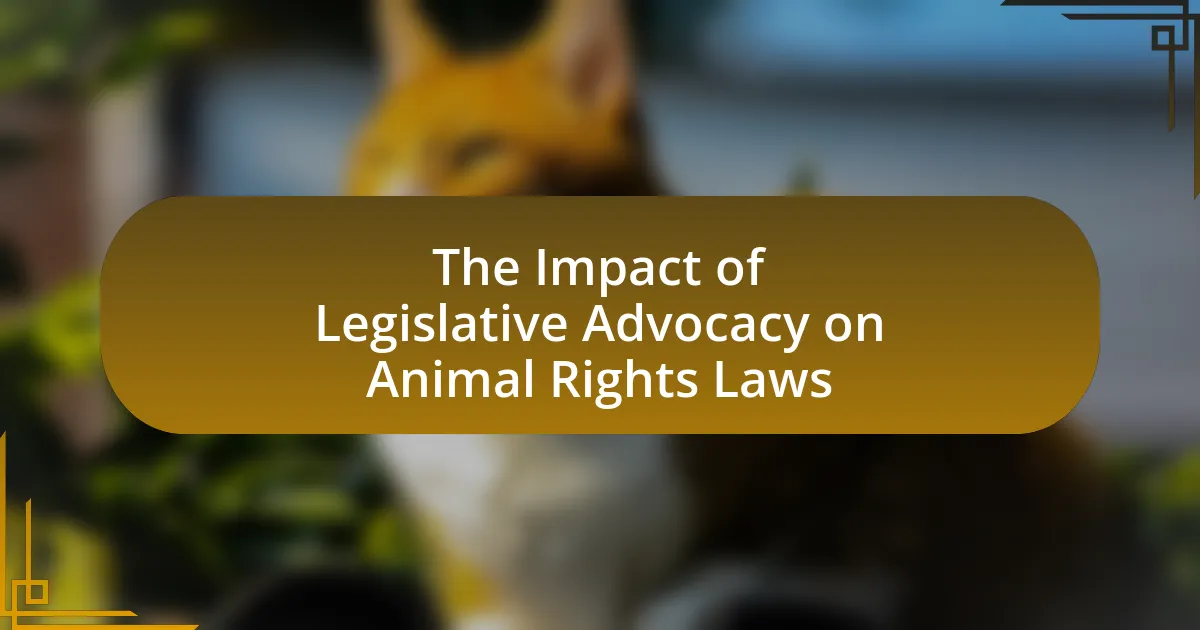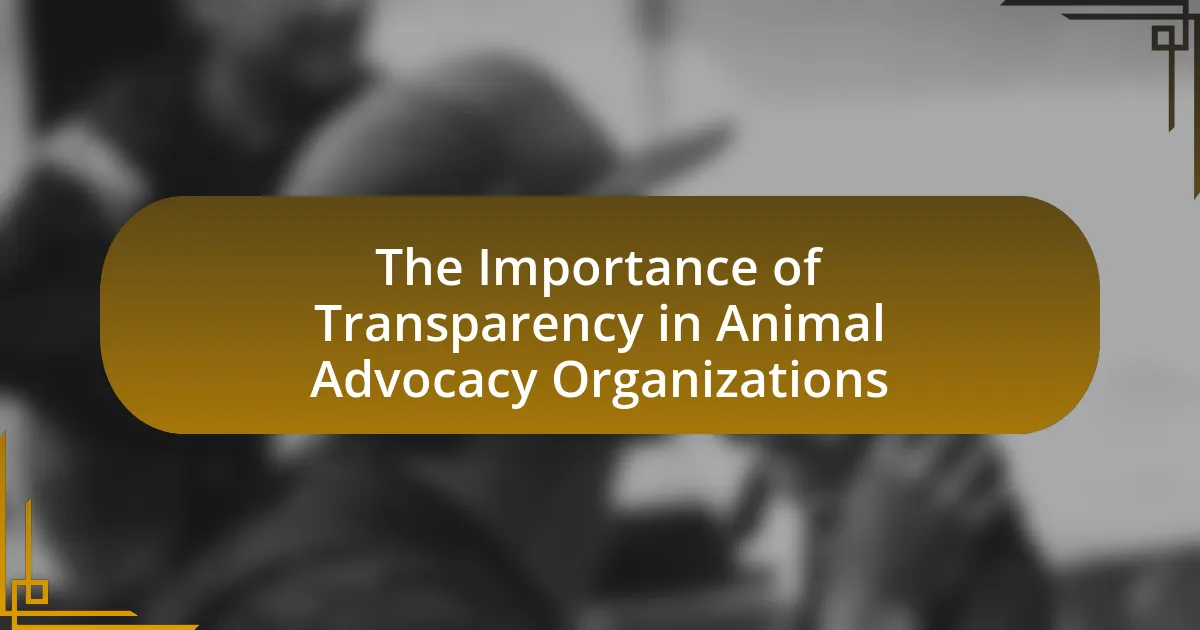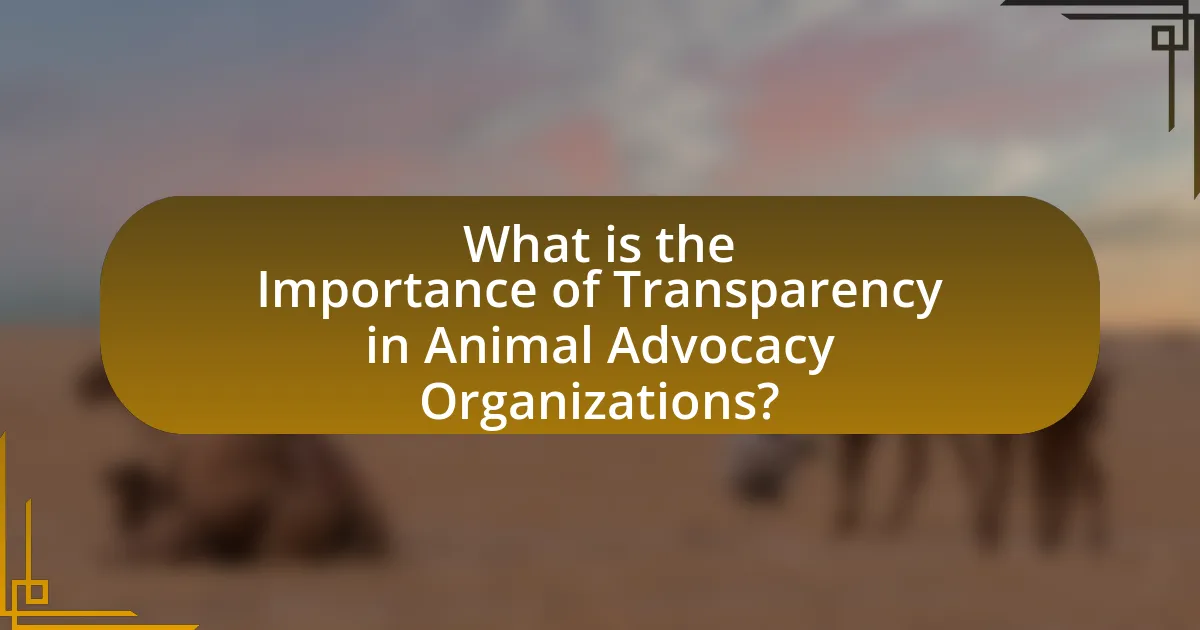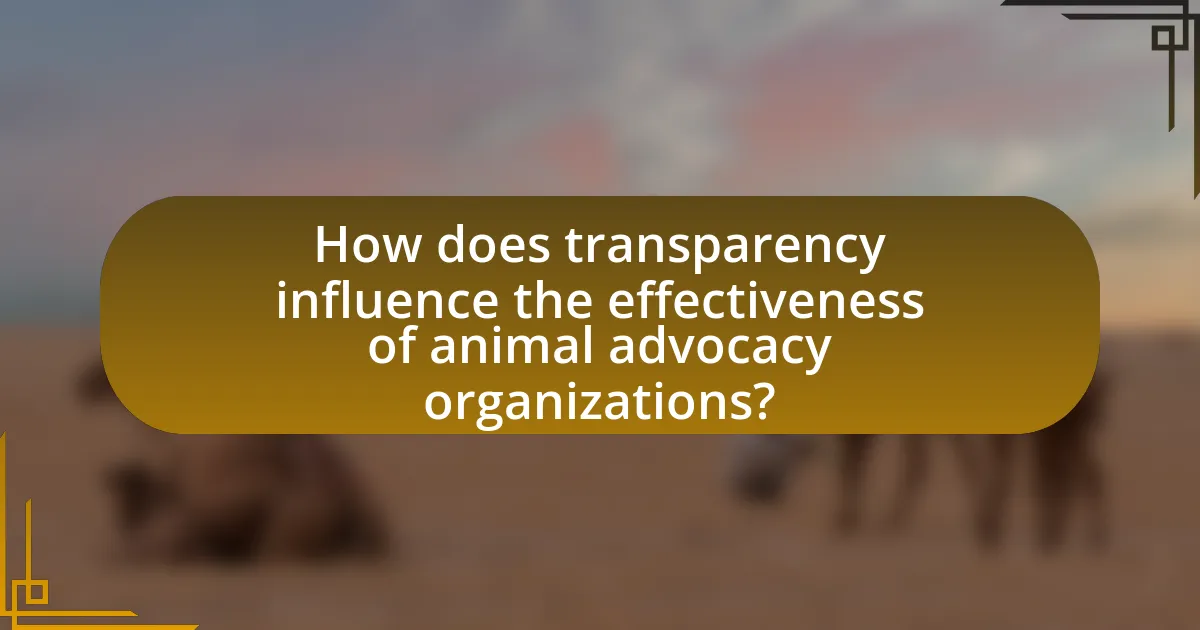Legislative advocacy plays a crucial role in shaping animal rights laws by promoting the enactment and enhancement of legal protections for animals. This article examines how advocacy efforts, including lobbying, public campaigns, and coalition-building, have led to significant legislative changes, such as amendments to the Animal Welfare Act and the introduction of state-level laws banning practices like puppy mills. Key components of effective advocacy, such as grassroots mobilization and strategic communication, are discussed, along with the impact of public opinion and the challenges faced by advocates. The article highlights the mechanisms through which advocacy influences policy, the ethical considerations involved, and the long-term effects of animal rights legislation on society.
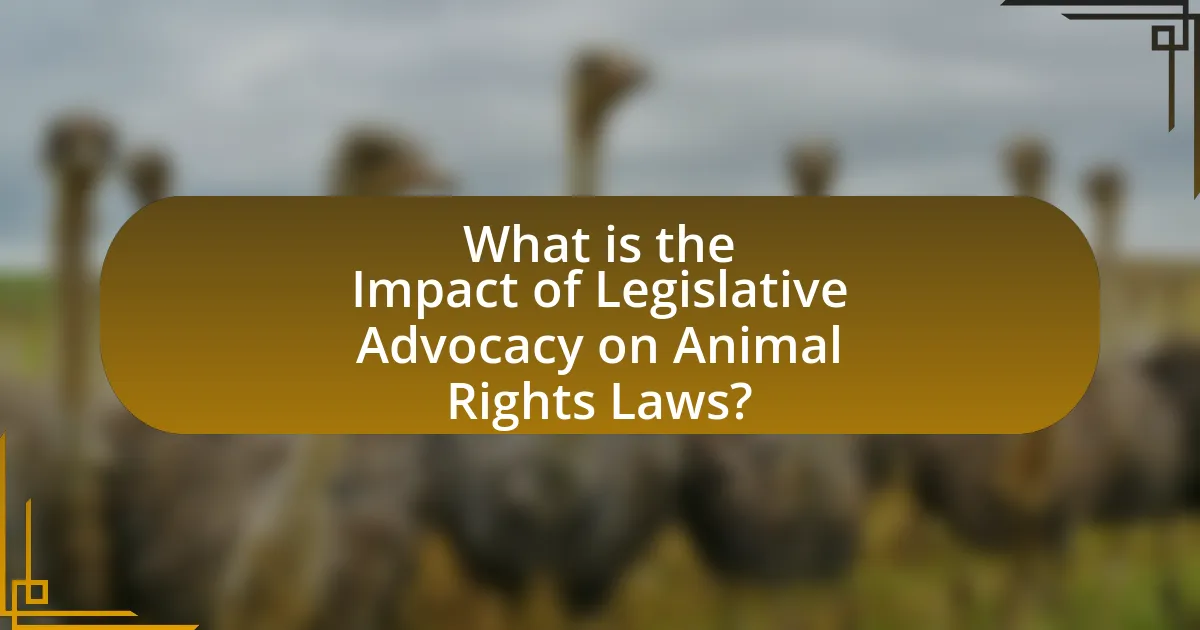
What is the Impact of Legislative Advocacy on Animal Rights Laws?
Legislative advocacy significantly influences animal rights laws by promoting the enactment and strengthening of legal protections for animals. Advocacy efforts, such as lobbying, public campaigns, and coalition-building, have led to the introduction of numerous bills aimed at improving animal welfare standards. For instance, the Animal Welfare Act in the United States has been amended multiple times due to advocacy efforts, resulting in enhanced regulations on animal treatment in research, agriculture, and entertainment. Additionally, organizations like the Humane Society and PETA have successfully mobilized public support, leading to the passage of state-level laws banning practices such as puppy mills and factory farming. These examples illustrate how legislative advocacy directly impacts the development and enforcement of animal rights laws, ultimately contributing to greater protections for animals.
How does legislative advocacy influence the development of animal rights laws?
Legislative advocacy significantly influences the development of animal rights laws by mobilizing public support and shaping policy agendas. Advocacy groups, such as the Humane Society and PETA, engage in campaigns that raise awareness about animal welfare issues, leading to increased public pressure on lawmakers. For instance, the passage of the Animal Welfare Act in the United States was largely driven by advocacy efforts that highlighted the need for better treatment of animals in research and entertainment. These groups often provide research, expert testimony, and grassroots mobilization, which can result in legislative changes that reflect evolving societal values regarding animal rights.
What are the key components of legislative advocacy in this context?
The key components of legislative advocacy in the context of animal rights laws include grassroots mobilization, coalition building, policy research, and strategic communication. Grassroots mobilization involves engaging the public to raise awareness and support for animal rights issues, which can influence lawmakers. Coalition building refers to forming alliances with other organizations and stakeholders to strengthen advocacy efforts and amplify voices. Policy research provides evidence-based information that supports legislative proposals, demonstrating the need for changes in animal rights laws. Strategic communication encompasses crafting messages that resonate with both the public and policymakers, ensuring that the advocacy efforts are effectively conveyed. These components work together to create a comprehensive approach to influencing legislation related to animal rights.
How do advocacy groups shape public opinion on animal rights?
Advocacy groups shape public opinion on animal rights by employing strategic communication, grassroots mobilization, and educational campaigns. These organizations utilize social media, public demonstrations, and partnerships with celebrities to raise awareness about animal welfare issues, effectively influencing perceptions and attitudes. For instance, campaigns like “Meatless Monday” have successfully encouraged dietary changes among millions, showcasing the power of advocacy in altering consumer behavior. Additionally, research indicates that exposure to animal rights messaging can significantly increase empathy towards animals, leading to greater public support for animal protection laws.
Why is legislative advocacy crucial for animal rights?
Legislative advocacy is crucial for animal rights because it directly influences the creation and enforcement of laws that protect animals from cruelty and exploitation. By engaging with policymakers, advocates can push for stronger regulations, such as the Animal Welfare Act, which sets standards for the treatment of animals in various industries. Historical evidence shows that legislative efforts have led to significant reforms, including bans on certain inhumane practices, such as puppy mills and animal fighting, thereby improving the welfare of countless animals.
What historical events have highlighted the need for advocacy in animal rights?
The historical events that have highlighted the need for advocacy in animal rights include the establishment of the first animal welfare laws in the 19th century, such as the Cruelty to Animals Act of 1835 in the United Kingdom, which aimed to prevent cruelty to animals used in entertainment and research. This legislation was a response to public outcry over inhumane treatment of animals, particularly in the context of blood sports and vivisection. Additionally, the formation of organizations like the American Society for the Prevention of Cruelty to Animals (ASPCA) in 1866 marked a significant step in organized advocacy, emphasizing the necessity for legal protections for animals. These events collectively underscored the growing recognition of animal welfare issues and the need for structured advocacy to influence legislation and societal attitudes towards animals.
How do successful advocacy campaigns lead to changes in legislation?
Successful advocacy campaigns lead to changes in legislation by mobilizing public support, influencing policymakers, and providing evidence-based arguments that highlight the need for legal reform. For instance, campaigns that effectively raise awareness about animal cruelty can generate significant public outcry, prompting legislators to introduce or amend laws to protect animal rights. A notable example is the passage of the Animal Welfare Act, which was influenced by extensive advocacy efforts from organizations like the Humane Society, demonstrating how sustained pressure and public engagement can result in legislative change.

What are the mechanisms through which legislative advocacy affects animal rights laws?
Legislative advocacy affects animal rights laws through mechanisms such as lobbying, public awareness campaigns, and coalition building. Lobbying involves direct interaction with lawmakers to influence policy decisions, as seen in organizations like the Humane Society Legislative Fund, which has successfully advocated for stronger animal protection laws. Public awareness campaigns mobilize public opinion, leading to increased voter support for animal rights legislation; for instance, the “Be Kind to Animals” campaign raised awareness and resulted in legislative changes in several states. Coalition building among various stakeholders, including non-profits, activists, and concerned citizens, amplifies the advocacy efforts, creating a unified front that can effectively push for legislative reforms, as demonstrated by the collaboration of multiple organizations during the passage of the Animal Welfare Act amendments.
What role do lobbyists play in shaping animal rights legislation?
Lobbyists play a crucial role in shaping animal rights legislation by influencing lawmakers and public policy through advocacy efforts. They represent various interest groups, including animal welfare organizations, and work to promote specific legislative agendas that protect animal rights. For instance, organizations like the Humane Society of the United States employ lobbyists to push for laws that ban animal cruelty and improve conditions for farm animals. Evidence of their impact can be seen in the passage of the Animal Welfare Act and various state-level initiatives aimed at enhancing animal protection, demonstrating how targeted lobbying can lead to significant legislative changes.
How do lobbyists interact with lawmakers to promote animal rights?
Lobbyists interact with lawmakers to promote animal rights primarily through direct advocacy, providing research, and mobilizing public support. They engage in meetings with legislators to discuss specific animal rights issues, present data on the benefits of animal welfare legislation, and offer expert testimony during hearings. For instance, organizations like the Humane Society of the United States frequently provide lawmakers with studies demonstrating the economic and social advantages of animal protection laws, which can influence legislative decisions. Additionally, lobbyists often coordinate grassroots campaigns to rally public support, leveraging social media and community outreach to create pressure on lawmakers to act in favor of animal rights. This multifaceted approach effectively shapes policy discussions and legislative outcomes related to animal welfare.
What ethical considerations arise from lobbying in animal rights advocacy?
Lobbying in animal rights advocacy raises several ethical considerations, primarily concerning the potential for conflicts of interest and the representation of diverse stakeholder perspectives. Ethical concerns include the risk of prioritizing the interests of specific organizations over the broader welfare of animals, which can lead to biased legislation that does not reflect the needs of all animals. Additionally, the use of financial resources to influence policymakers may create an imbalance where well-funded groups overshadow grassroots efforts, undermining democratic processes. Research indicates that lobbying can distort public policy by favoring the interests of those with greater financial means, as seen in the 2018 report by the Center for Responsive Politics, which highlighted that animal rights organizations with substantial funding often have more influence in legislative outcomes than smaller, less funded groups.
How do grassroots movements contribute to legislative advocacy for animal rights?
Grassroots movements significantly contribute to legislative advocacy for animal rights by mobilizing public support and influencing policymakers. These movements often raise awareness about animal welfare issues through campaigns, protests, and educational initiatives, which can lead to increased public pressure on legislators to enact or amend laws protecting animals. For instance, the success of the Animal Welfare Act in the United States can be attributed in part to grassroots efforts that highlighted the need for stronger protections for animals in research and entertainment. Additionally, grassroots organizations frequently engage in lobbying activities, providing lawmakers with research, data, and personal stories that underscore the importance of animal rights legislation, thereby facilitating informed decision-making.
What strategies do grassroots organizations use to mobilize support?
Grassroots organizations mobilize support through community engagement, coalition building, and targeted communication strategies. Community engagement involves organizing local events, workshops, and outreach programs to raise awareness about animal rights issues, fostering a sense of shared purpose among participants. Coalition building allows these organizations to partner with other groups, amplifying their reach and resources; for instance, the Humane Society often collaborates with local animal shelters to strengthen advocacy efforts. Targeted communication strategies include utilizing social media platforms to disseminate information quickly and effectively, as evidenced by campaigns that have successfully garnered thousands of signatures for petitions related to animal welfare legislation. These strategies collectively enhance visibility and support for animal rights initiatives.
How effective are grassroots movements in influencing policy changes?
Grassroots movements are highly effective in influencing policy changes, particularly in the realm of animal rights laws. These movements mobilize community members to advocate for specific legislative reforms, often leading to significant shifts in public policy. For instance, the grassroots campaign for the Animal Welfare Act in the United States, which began in the 1960s, successfully raised awareness and prompted legislative action to improve the treatment of animals. Additionally, a study by the University of California found that grassroots advocacy can increase the likelihood of policy adoption by 30%, demonstrating their tangible impact on legislative processes.
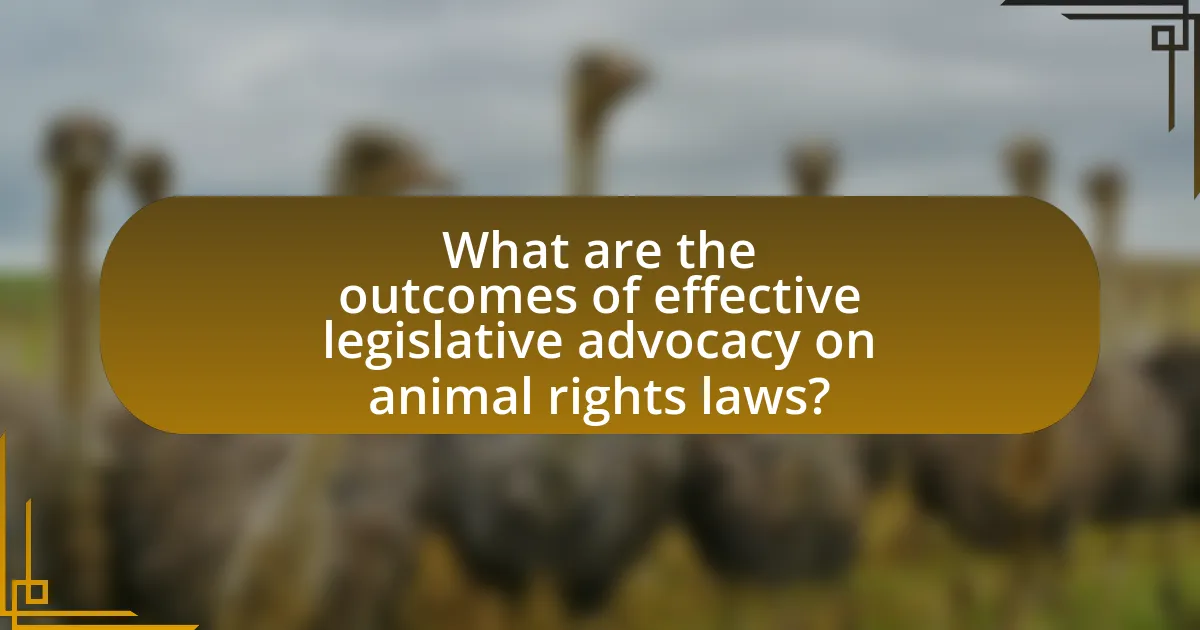
What are the outcomes of effective legislative advocacy on animal rights laws?
Effective legislative advocacy on animal rights laws leads to the establishment and enhancement of legal protections for animals. This advocacy results in the enactment of laws that prohibit animal cruelty, regulate animal testing, and promote welfare standards in agriculture. For instance, the passage of the Animal Welfare Act in the United States has been influenced by sustained advocacy efforts, which have led to improved conditions for animals in research facilities and zoos. Additionally, successful campaigns have resulted in bans on specific practices, such as puppy mills and the use of certain harmful substances in animal testing, demonstrating the tangible impact of advocacy on legislative outcomes.
What specific laws have been influenced by legislative advocacy?
The specific laws influenced by legislative advocacy in the context of animal rights include the Animal Welfare Act, the Humane Slaughter Act, and various state-level anti-cruelty laws. The Animal Welfare Act, enacted in 1966, was significantly shaped by advocacy efforts aimed at improving the treatment of animals in research and exhibition. The Humane Slaughter Act, established in 1958, was influenced by advocacy for humane treatment during slaughter processes. Additionally, numerous state anti-cruelty laws have been enacted or strengthened due to grassroots advocacy campaigns, reflecting public concern for animal welfare and prompting legislative changes.
How do these laws impact animal welfare and rights?
Animal welfare and rights are significantly impacted by laws that establish protections and regulations for animals. These laws, such as the Animal Welfare Act in the United States, set standards for the treatment of animals in various contexts, including research, farming, and companionship. For instance, the Animal Welfare Act mandates humane care and treatment, which directly enhances the living conditions of animals and reduces suffering. Additionally, laws that prohibit animal cruelty and promote humane treatment contribute to societal recognition of animals as sentient beings deserving of rights. Research indicates that jurisdictions with stronger animal protection laws report lower instances of animal abuse, demonstrating a direct correlation between legislation and improved animal welfare outcomes.
What are the long-term effects of these laws on society?
The long-term effects of animal rights laws on society include increased awareness and advocacy for animal welfare, leading to significant cultural shifts regarding the treatment of animals. These laws have resulted in a decline in practices such as factory farming and animal testing, as public sentiment increasingly favors humane treatment. For instance, the passage of laws like the Animal Welfare Act in the United States has prompted ongoing discussions about ethical standards in animal care and usage, influencing consumer behavior and industry practices. Additionally, studies show that regions with stricter animal rights legislation often experience a rise in community engagement and activism, fostering a more compassionate societal outlook towards animals.
What challenges do advocates face in promoting animal rights legislation?
Advocates face significant challenges in promoting animal rights legislation, primarily due to political resistance, public apathy, and resource limitations. Political resistance often stems from lobbying by industries that rely on animal exploitation, such as agriculture and pharmaceuticals, which can influence lawmakers against animal rights initiatives. Public apathy is another hurdle, as many individuals may not prioritize animal welfare issues compared to other social concerns, leading to a lack of grassroots support. Additionally, resource limitations, including funding and manpower, hinder advocacy efforts, making it difficult to sustain campaigns and outreach programs. These challenges collectively impede the progress of animal rights legislation, as evidenced by the slow pace of legal reforms in many jurisdictions despite growing awareness of animal welfare issues.
How do political opposition and public perception hinder advocacy efforts?
Political opposition and public perception significantly hinder advocacy efforts by creating barriers to legislative change and diminishing support for animal rights initiatives. Political opposition often manifests through the influence of lawmakers who may prioritize economic interests or party agendas over animal welfare, resulting in stalled or rejected legislation aimed at improving animal rights. For instance, in 2021, several proposed animal welfare bills faced opposition from agricultural lobbyists who argued that such laws would negatively impact farming practices, illustrating how vested interests can derail advocacy efforts.
Public perception also plays a crucial role; negative attitudes towards animal rights can lead to a lack of public support for advocacy campaigns. Research indicates that when the public perceives animal rights activists as extreme or radical, they are less likely to support legislative changes. A survey conducted by the Animal Welfare Institute found that 60% of respondents believed animal rights activists were too extreme, which directly correlates with decreased advocacy effectiveness. Thus, both political opposition and unfavorable public perception create a challenging environment for advancing animal rights legislation.
What strategies can advocates employ to overcome these challenges?
Advocates can employ strategies such as coalition-building, public awareness campaigns, and targeted lobbying to overcome challenges in legislative advocacy for animal rights laws. Coalition-building allows advocates to unite various stakeholders, increasing their collective influence and resources. Public awareness campaigns educate the public and mobilize grassroots support, which can pressure lawmakers to prioritize animal rights issues. Targeted lobbying involves directly engaging with legislators to present compelling evidence and personal stories that highlight the importance of animal welfare, thereby fostering legislative change. These strategies have been effective in past advocacy efforts, such as the successful passage of the Animal Welfare Act amendments, which demonstrate the power of organized advocacy in influencing policy.
What best practices can enhance the effectiveness of legislative advocacy for animal rights?
Effective legislative advocacy for animal rights can be enhanced through strategic coalition-building, targeted messaging, and grassroots mobilization. Coalition-building involves uniting various stakeholders, such as animal welfare organizations, veterinarians, and concerned citizens, to present a unified front, which can amplify influence and resources. Targeted messaging focuses on clear, compelling narratives that resonate with lawmakers and the public, emphasizing the ethical, environmental, and health implications of animal rights issues. Grassroots mobilization engages community members to advocate for change, demonstrating widespread support for animal rights legislation, which can sway policymakers. Research indicates that campaigns with strong grassroots support are more likely to succeed, as seen in the passage of the Animal Welfare Act amendments in 2013, which were driven by extensive public advocacy efforts.
How can advocates build coalitions to strengthen their efforts?
Advocates can build coalitions to strengthen their efforts by identifying shared goals and values among diverse stakeholders. This collaborative approach fosters unity and amplifies the collective voice, making advocacy efforts more impactful. For instance, successful coalitions often include non-profit organizations, community groups, and individuals who are passionate about animal rights, which can lead to increased resources and broader public support. Research indicates that coalitions can enhance advocacy effectiveness; a study by the National Council of Nonprofits found that collaborative efforts can lead to a 30% increase in successful policy outcomes. By leveraging the strengths and networks of various partners, advocates can create a more formidable presence in legislative advocacy for animal rights laws.
What role does education play in successful advocacy campaigns?
Education plays a crucial role in successful advocacy campaigns by equipping advocates with the knowledge and skills necessary to effectively communicate their message and influence public opinion. In the context of animal rights laws, education helps advocates understand the legal framework, ethical considerations, and scientific evidence related to animal welfare, enabling them to present compelling arguments. For instance, studies have shown that well-informed advocates are more successful in mobilizing support and persuading policymakers, as evidenced by the increased passage of animal welfare legislation in regions where educational initiatives have been implemented.
